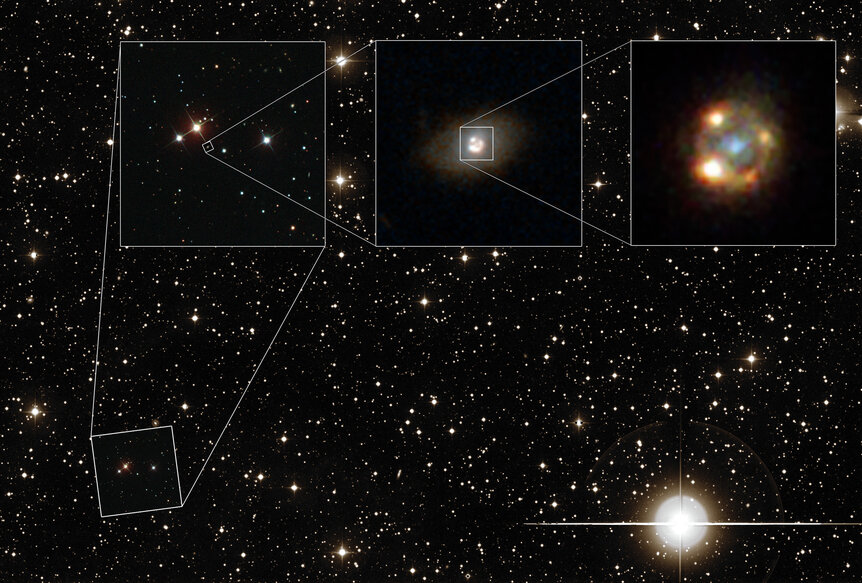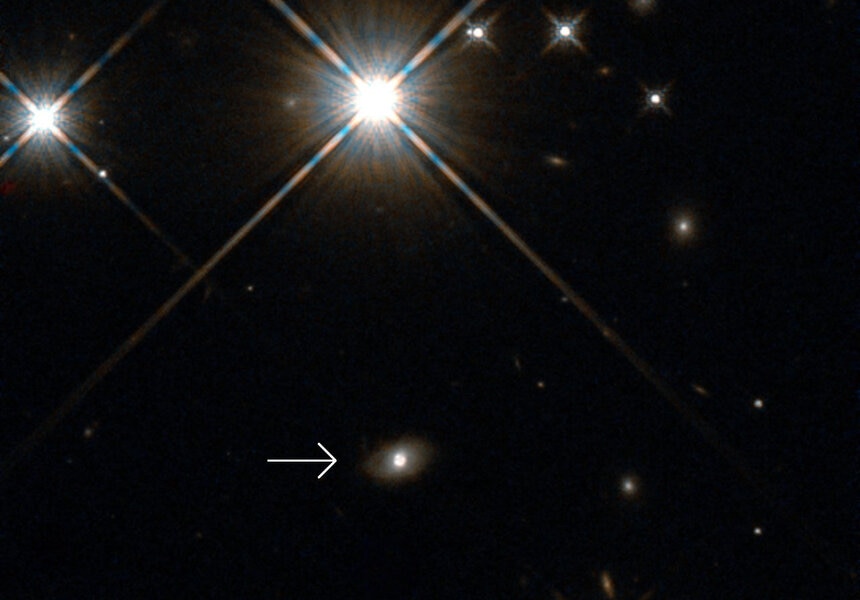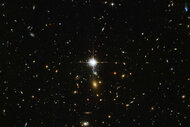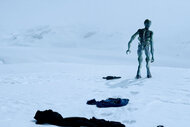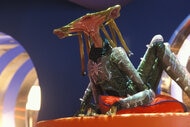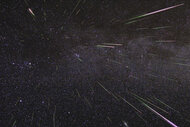Create a free profile to get unlimited access to exclusive videos, sweepstakes, and more!
Gravity warps a supernova into a quadruple play
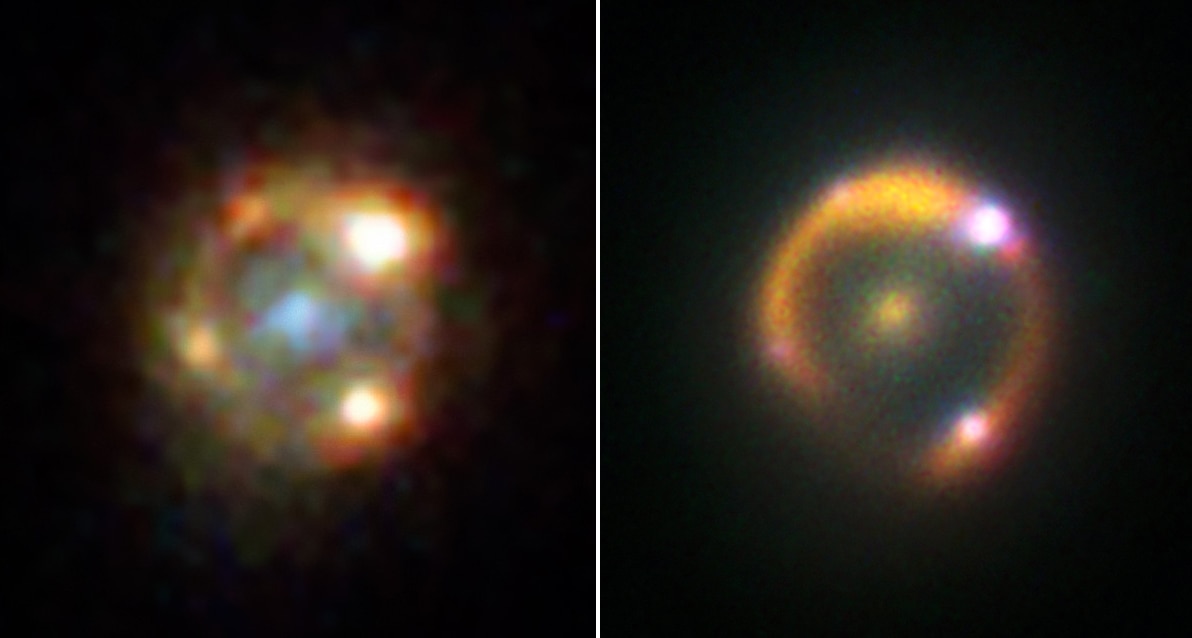
The Universe is a weird place.
Follow along with me here. First, the idea that there are stars at all is kind of amazing. Then some of them use up all their fuel, blow their outer layers in space, and leave behind their hot, dense cores. These objects, called white dwarfs, are so dense that a cubic centimeter of one (about the size of a six-sided die) would weigh a ton.
And if this white dwarf is orbiting another star, it can draw hydrogen off that star, let it pile up on its surface, compress it, and possibly get so much that it sets off a catastrophic wave of fusion that is so powerful it blows the star to smithereens. This explosion is so bright it can be seen for billions of light-years, and moreover is so consistent from white dwarf to white dwarf that we can use them as a meter stick of sorts, measuring the distances to objects clear across the visible Universe.
Still with me? Because it gets weirder. If that light from that supernova happens to pass a galaxy on its way here, the gravity of that galaxy can warp the light's path, bend it, amplifying that light and even breaking it up into multiple images, like seeing a light bulb through broken glass. We call this a gravitational lens (predicted in Einstein's relativity theory), where the distant supernova is the lensed object and the galaxy in between us is the lens.
And oh, I'm not done yet. There's more weirdness to be had here, but first let me show you a wondrous example of all this: the supernova iPTF6geu:
It doesn't look much like a supernova, does it? What's that weird ring and all that other stuff?
Well, the white dwarf that blew its lid long, long ago. It took 4.4 billion years for this light to reach us! That light had traveled for nearly 2 billion years toward us when it passed by an unnamed elliptical galaxy. This nondescript galaxy has the combined gravity of billions of stars, enough to warp space itself, and that warp distorted the light from the supernova. In fact, from our point of view on Earth, 2.6 billion light-years from the lensing galaxy, the supernova was broken up into four separate images, seen as spots around a ring. That ring is the lensed galaxy, the host galaxy for the supernova, similarly distorted by the lensing galaxy’s gravity.
The supernova was discovered in the Intermediate Palomar Transient Factory (or iPTF, which is in the supernova's name), a project that takes deep images of the sky and looks for things that change. When the white dwarf blew up it got much brighter and appeared in the iPTF survey, where an astronomer noticed it. It was quickly found to be an explosion from a white dwarf (what we call a Type Ia supernova), which again are important because they can be used to measure the size of the Universe. Follow-up observations were quickly scheduled, including using the orbiting Hubble telescope and the ground-based Keck telescope in Hawaii.
The four different spots, mind you, are all the supernova! Each is from a slightly different path taken by the exploding star's light. The total magnification by the lensing is pretty big; the supernova appears over 50 times brighter than it would have if the galaxy hadn't gotten in the way!
Like I said, this is all very weird. But there's one more weirdness left.
I was surprised by how much brighter the two brightest spots are versus the fainter two (the brightest is A, then B, C, D, going clockwise, which is also coincidentally the order of their brightness). It turns out the amount of brightness amplification depends on the shape of the underlying lensing galaxy; a little bit more on one side versus the other and the lensed object gets distorted differently.
It turns out there's more to it than this. According to the models of the lensing galaxy, the two brightest spots should only be about twice as bright as the dimmer two, but spot A is 15 times brighter than spot C, and B is five times brighter! To an astronomer, an obvious possibility is dust in the lensing galaxy obscuring C and D a little bit; if the light path for those two images went through a big dust cloud they’d look dimmer. But that can’t be the case: The brightnesses of the spots in the infrared Keck images are about the same as in the Hubble images, but you'd expect the dust to affect visible light images more than infrared (infrared light doesn’t have as much trouble getting through dust as visible light).
Something else must be causing this overamplification of A and B. And the answer is … gravitational lensing! But this time, it's not the total mass of the galaxy that's causing the lensing, it's most likely due to stars in the galaxy. If the light from the distant supernova passes close to a star in that galaxy, that can bend its light as well. Since the object doing the lensing (a star) is so much smaller than a galaxy, we call this microlensing.
That's likely what happened here: The supernova light passed by some stars at just the right distance to further amplify its brightness and create spots A and B, but by chance the light for D passed by a star in such a way that some of the light was bent away from us, causing it to appear dimmer than it otherwise would. C was the only spot not to be affected by miscrolensing.
So not only was this supernova lensed four times by the intervening galaxy, each lensed image was further microlensed by stars in that galaxy!
What a mess. A weird, weird mess.
But a wonderful one! All of these events, happening they way they did, all literally lining up so that we could see the titanic blast of a star from much farther away than we should. And it's the combination of astrophysics, nuclear physics, stellar dynamics, relativity theory, and even things like engineering, optics, and rocket science that allowed us to see, examine, and comprehend it!
Oh yes, the Universe is weird. But it's our Universe, and it's one we understand better every day.
